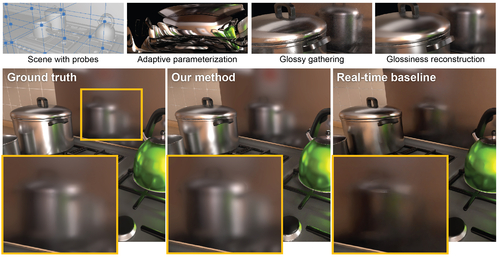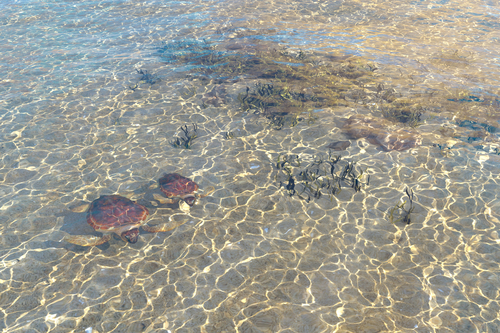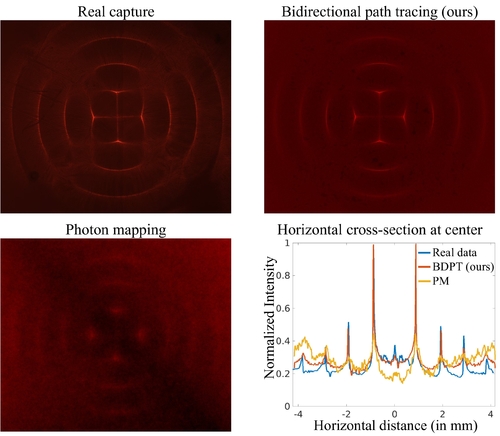Pre-recorded Sessions: From 4 December 2020 | Live Sessions: 10 – 13 December 2020
4 – 13 December 2020
Pre-recorded Sessions: From 4 December 2020 | Live Sessions: 10 – 13 December 2020
4 – 13 December 2020
#SIGGRAPHAsia | #SIGGRAPHAsia2020
#SIGGRAPHAsia | #SIGGRAPHAsia2020











Date: Saturday, December 12th
Time: 12:30pm - 1:00pm
Venue: Zoom Room 3
Note: All live sessions will be screened on Singapore Time/GMT+8. Convert your time zone here.
Abstract: Recent rendering advances dramatically reduce the cost of global illumination. But even with hardware acceleration, complex light paths with multiple glossy interactions are still expensive; our new algorithm stores these paths in precomputed light probes and reprojects them at runtime to provide interactivity. Combined with traditional light maps for diffuse lighting our approach interactively renders all light paths in static scenes with opaque objects. Naively reprojecting probes with glossy lighting is memory-intensive, requires efficient access to the correctly reflected radiance, and exhibits problems at occlusion boundaries in glossy reflections. Our solution addresses all these issues. To minimize memory, we introduce an adaptive light probe parameterization that allocates increased resolution for shinier surfaces and regions of higher geometric complexity. To efficiently sample glossy paths, our novel gathering algorithm reprojects probe texels in a view-dependent manner using efficient reflection estimation and a fast rasterization-based search. Naive probe reprojection often sharpens glossy reflections at occlusion boundaries, due to changes in parallax. To avoid this, we split the convolution induced by the BRDF into two steps: we precompute probes using a lower material roughness and apply an adaptive bilateral filter at runtime to reproduce the original surface roughness. Combining these elements, our algorithm interactively renders complex scenes while fitting in the memory, bandwidth, and computation constraints of current hardware.
Author(s)/Presenter(s):
Simon Rodriguez, Institut national de recherche en informatique et en automatique (INRIA), Université Côte d'Azur, France
Thomas Leimkuhler, Institut national de recherche en informatique et en automatique (INRIA), Université Côte d'Azur, France
Siddhant Prakash, Institut national de recherche en informatique et en automatique (INRIA), Université Côte d'Azur, France
Chris Wyman, NVIDIA, United States of America
Peter Shirley, NVIDIA, United States of America
George Drettakis, Institut national de recherche en informatique et en automatique (INRIA), Université Côte d'Azur, France

Abstract: In scenes lit with sharp point-like light sources, light can bounce several times on specular materials before getting into our eyes, forming purely specular light paths. However, to our knowledge, rendering such multi-bounce pure specular paths has not been handled in previous work: while many light transport methods have been devised to sample various kinds of light paths, none of them are able to find multi-bounce pure specular light paths from a point light to a pinhole camera. In this paper, we present path cuts to efficiently render such light paths. We use a path space hierarchy combined with interval arithmetic bounds to efficiently prune non-contributing regions of path space, and to slice the path space into regions small enough to empirically contain at most one solution. Next, we use an automatic differentiation tool and a Newton-based solver to find an admissible specular path within a given path space region. We demonstrate results on several complex specular configurations, including RR, TT, TRT and TTTT paths.
Author(s)/Presenter(s):
Beibei Wang, Nanjing University of Science and Technology, China
Miloš Hašan, Adobe Research, United States of America
Ling-Qi Yan, University of California Santa Barbara, United States of America

Abstract: Monte Carlo light transport simulations often lack robustness in scenes containing specular or near-specular materials. Widely used uni- and bidirectional sampling strategies tend to find light paths involving such materials with insufficient probability, producing unusable images that are contaminated by significant variance. This article addresses the problem of sampling a light path connecting two given scene points via a single specular reflection or refraction, extending the range of scenes that can be robustly handled by unbiased path sampling techniques. Our technique enables efficient rendering of challenging transport phenomena caused by such paths, such as underwater caustics or caustics involving glossy metallic objects. We derive analytic expressions that predict the total radiance due to a single reflective or refractive triangle with a microfacet BSDF and we show that this reduces to the well known Lambert boundary integral for irradiance. We subsequently show how this can be leveraged to efficiently sample connections on meshes comprised of vast numbers of triangles. Our derivation builds on the theory of off-center microfacets and involves integrals in the space of surface slopes. Our approach straightforwardly applies to the related problem of rendering glints with high-resolution normal maps describing specular microstructure. Our formulation alleviates problems raised by singularities in filtering integrals and enables a generalization of previous work to perfectly specular materials. We also extend previous work to the case of GGX distributions and introduce new techniques to improve accuracy and performance.
Author(s)/Presenter(s):
Guillaume Loubet, EPFL, Switzerland
Tizian Zeltner, EPFL, Switzerland
Nicolas Holzschuch, Institut national de recherche en informatique et en automatique (INRIA), France
Wenzel Jakob, EPFL, Switzerland

Abstract: We present a novel chi-squared progressive photon mapping algorithm (CPPM) that constructs an estimator by controlling the bandwidth to obtain superior image quality. Our estimator has parametric statistical advantages over prior nonparametric methods. First, we show that when a probability density function of the photon distribution is subject to uniform distribution, the radiance estimation is theoretically unbiased. Next, the local photon distribution is evaluated via chi-squared test to determine whether the photons follow the hypothesized distribution (uniform distribution) or not. If the statistical test deems that the photon distribution inside the bandwidth permits unbiased estimation, bandwidth reduction should be suspended. Finally, we present a pipeline with a bandwidth retention and conditional reduction scheme according to the test results. This pipeline not only accumulates sufficient photons for a reliable chi-squared test but also theoretically guarantees that the estimate converges to the correct solution. We evaluate our method on various benchmarks and observe significant improvement in the running time and rendering quality in terms of mean squared error over prior progressive photon mapping methods.
Author(s)/Presenter(s):
Zehui Lin, Peking University, China
Sheng Li, Peking University, China
Xinlu Zeng, Peking University, China
Congyi Zhang, Peking University, China
Jinzhu Jia, Peking University, China
Guoping Wang, Peking University, China
Dinesh Manocha, University of Maryland College Park, University of North Carolina at Chapel Hill (UNC), United States of America

Abstract: Rendering radiative transfer through media with a heterogeneous refractive index is challenging because the continuous refractive index variations result in light traveling along curved paths. Existing algorithms are based on photon mapping techniques, and thus are biased and result in strong artifacts. On the other hand, existing unbiased methods such as path tracing and bidirectional path tracing cannot be used in their current form to simulate media with a heterogeneous refractive index. We change this state of affairs by deriving unbiased path tracing estimators for this problem. Starting from the refractive radiative transfer equation (RRTE), we derive a path-integral formulation, which we use to generalize path tracing with next-event estimation and bidirectional path tracing to the heterogeneous refractive index setting. We then develop an optimization approach based on fast analytic derivative computations to produce the point-to-point connections required by these path tracing algorithms. We propose several acceleration techniques to handle complex scenes (surfaces and volumes) that include participating media with heterogeneous refractive fields. We use our algorithms to simulate a variety of scenes combining heterogeneous refraction and scattering, as well as tissue imaging techniques based on ultrasonic virtual waveguides and lenses. Our algorithms and publicly-available implementation can be used to characterize imaging systems such as refractive index microscopy, schlieren imaging, and acousto-optic imaging, and can facilitate the development of inverse rendering techniques for related applications.
Author(s)/Presenter(s):
Adithya Pediredla, Carnegie Mellon University, United States of America
Yasin Karimi Chalmiani, Carnegie Mellon University, United States of America
Matteo Giuseppe Scopelliti, Carnegie Mellon University, United States of America
Maysamreza Chamanzar, Carnegie Mellon University, United States of America
Srinivasa Narasimhan, Carnegie Mellon University, United States of America
Ioannis Gkioulekas, Carnegie Mellon University, United States of America
